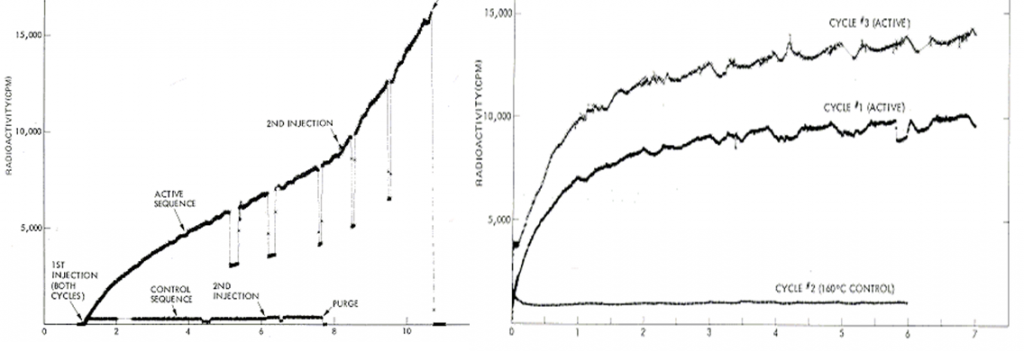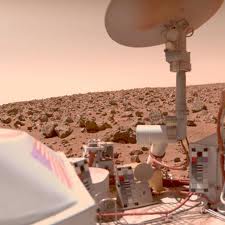Two headlines appeared in papers published on April 12 and 13 this year. One stated “Life on Mars Discovered from Decades Old Data” and the other used this headline, “NASA robots found life on Mars in 1976, scientists say.”
In 1976 the United States Viking-1 and Viking-2 soft landed on Mars and gave us our first experimental results on sampled Martian soil. In my last blog on robotic missions to the red planet I mentioned the Label Release Experiment and its results. Gilbert Levin and Patricia Ann Straat designed this experiment to detect microbial life. Short of having a microscope in which to view Martian bacteria, this experiment consistently matched control experiments done on earth.
The Label Release Experiment used a sample of soil dug up by the Viking trenching tool. The soil was placed in a sealed compartment on board the lander. A dilute aqueous solution with uniformly labelled carbon compounds was added to the soil. The atmospheric output of the soil was measured to monitor the appearance of radioactive gases. A repeat of the experiment was then conducted with a duplicate soil sample heated to 160 degrees Celsius (320 Fahrenheit). The atmospheric output was measured again. A comparison of the results from both terrestrial and Martian soil samples is seen below.

At the time when these test results were known they were discounted by contradictory results from another test looking for organic molecules. That test showed none in Viking derived samples. But an Earth-based control test in Antarctica also showed no organic molecules. NASA chose to err on the side of caution and concluded that there was no evidence of life on Mars.
Recently, however, scientists have revisited the data from Viking and concluded that bacterial life exists on Mars, discounting the original NASA conclusions that Viking experiments were inconclusive or could be explained by geochemistry. Using a numerical approach the scientists have published their results in the International Journal of Aeronautical and Space Sciences. In analyzing the results for complexity consistent with living systems rather than non-biological processes the scientists concluded that there was evidence to support with 99% certainty that microbial life exists on Mars.
The implications of finding life on another planet are enormous. Future robotic expeditions may finally send us confirmation of what the two Viking landers discovered over 35 years ago. The importance of the discovery of life on Mars in light of NASA’s initial reluctance to support its own experimental findings is somewhat puzzling.

















NASA is NOT a high-priority of the Obama Administration. Congress and the Executive Branch are working to correct two issues that have all of their focus: Job Loss correction from the Great Recession; and paying for the large deficits run up by fighting two ten-year wars abroad. The world’s economies in the developed countries have stagnated.
Back in the sixties, I was in attendance of a seminar by Werner Von Braun in Huntsville, Alabama. His vision of deep space exploration was to do it via space station development. Creating outposts and fuel depots in orbit around the Moon, or Mars, or any other planet, makes a lot of sense. It would greatly cut costs and create a better chance for both success and sustainability. (Just my opinion!)
NASA has been put on hold for quite a while. It didn’t just start with the current administration. The Space Shuttle program sucked up much of NASA’s annual budget providing little in the way of new technology. You are absolutely right that two decades of warfare played a part in redefining the drivers for innovation in the United States. The besieged mentality of Homeland Security has further contributed to America’s withdrawal from looking outward. NASA alone will not restore human exploration of space beyond low-Earth orbit.
What will the drivers be?
1. The rising aspirations of new political players like China and India who both see human activity in space as a coming of age statement.
2. Pooling of capital from many national players with a defined mission may prove to be the way forward. The confirmation of finding life on Mars may be that stimulus to get our outward urge going again. The re-examination of the results from the Viking experiments has made the next robotic mission to Mars, Curiosity, one that is engendering considerable interest.
3. The emergence of for-profit players who will find bottom-line value in space. Will the abundance of Helium3 on the Moon be seen as worthwhile to a mining conglomerate or a public-private partnership? Will mineral-rich near-Earth asteroids be exploited? Will space habitations, way-stations and private space research labs become common by the end of the 21st century?